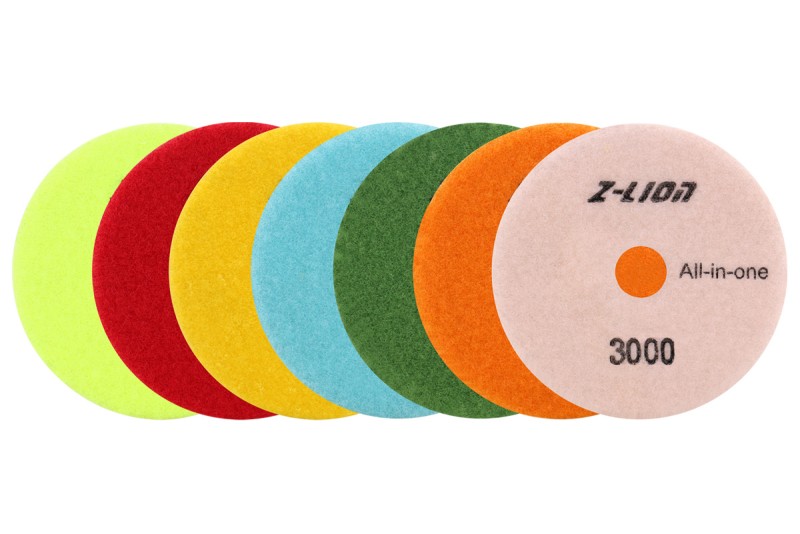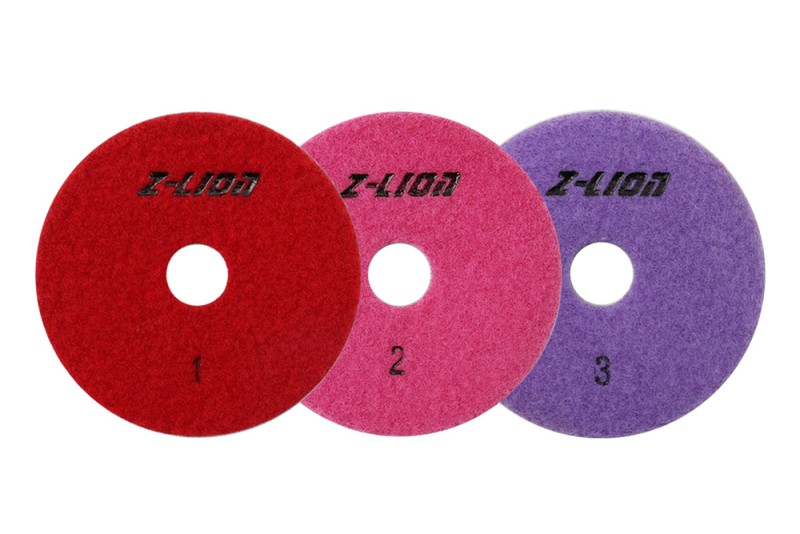
Why 3 Step Polishing Pads Are More and More Popular?
Diamond Wet Polishing Pads: The Ultimate Tool for Versatile Surface Preparation
In the world of surface finishing, diamond wet polishing pads (also known as diamond soft discs) have become an essential tool for achieving high-quality results on a wide range of materials. These flexible processing tools combine diamond as an abrasive with a composite material, making them ideal for polishing and finishing surfaces such as stone, ceramic, glass and floor tiles.
Features of diamond wet polishing pads
1. Construction and design:
Diamond wet polishing pads consist of diamond particles embedded in a flexible backing material, usually with a nylon cloth on the back. This design allows for easy mounting to the grinder, allowing for efficient polishing.
The flexibility of the mats allows them to conform to irregular surfaces, making them suitable for a wide range of applications.
2. Widely used:
These shims are particularly useful for machining irregular materials including stone, ceramic, glass and various tiles. They are commonly used for:
Stone polishing: To achieve a high gloss finish on natural stones such as granite and marble.
Line chamfer: Create smooth edges and corners on stone and tile surfaces.
Processing of curved panels and irregular stones: adapting to the contours of complex shapes to obtain refined results.
3. Powerful grinding power:
Diamond wet polishing pads are known for their strong abrasiveness, which allows them to efficiently remove material while maintaining surface integrity. This ability is critical to achieving the desired polishing results without damaging the underlying material.
Application in surface treatment
1. Marble and concrete restoration:
Diamond wet polishing pads are widely used for the repair and renovation of marble and concrete surfaces. They are effective in restoring the original gloss and clarity to worn or damaged surfaces and are ideal for both residential and commercial applications.
2. Terrazzo and glass-ceramic:
These pads are also suitable for polishing terrazzo and glass-ceramic, providing a smooth, shiny surface that enhances the beauty of these materials.
3. Artificial stone and floor tiles:
Diamond wet polishing pads are versatile and suitable for use on engineered stone and all types of floor tiles, including glazed and vitrified tiles. They can be used to create a high gloss finish, improving the overall appearance and durability of your floor.
The Evolution of Wet Polishing Pads: From Seven Steps to Streamlined Efficiency
Traditionally, these polishing pads typically use a seven-step process, using grits ranging from 50 to 3000 grit.
Learn about the seven-step polishing pad

The seven-step polishing pad is designed to provide a comprehensive polishing solution, allowing users to achieve a smooth and shiny surface through a systematic approach. The grinding sequence usually includes:
#50: Coarse sand, used for removing heavy objects and initial shaping.
#100: Further refines the surface and smoothes out imperfections left by the coarse sanding.
#200: Continue the smoothing process to prepare the surface for finer grit.
#400: Begins to polish the surface, enhancing clarity and reducing scratches.
#800: Further refines the surface treatment and brings out the natural beauty of the material.
#1500: Prepares the surface for the final polishing stage, ensuring a high level of smoothness.
#3000: The finest grit, used to achieve a high gloss finish.
The rise of the three-step polishing pad

As the industry evolves, more and more manufacturers are choosing to adopt three-step polishing pads as a more efficient alternative. This innovation simplifies the polishing process by combining the traditional grinding steps into three distinct stages:
Coarse grinding: The first step utilizes coarse grit to remove bulk material and prepare the surface.
Medium grinding: The second step uses medium grit to further polish the surface and eliminate scratches.
Fine grinding: The final step uses fine grit to achieve a polished effect.
Advantages of three-step polishing pads
1. Cost saving:
Reduced labor costs: With fewer polishing steps, the labor costs required are also reduced to achieve the same high-quality polishing results. The reduction in labor costs means significant cost savings for manufacturers, especially in a high-volume production environment.
Reduce material costs: Three-step polishing pads often use a new composite abrasive that combines sharpness and durability. This innovation reduces the need for frequent replacement, further reducing material costs.
2. Time efficiency:
Faster polishing process: A streamlined three-step process completes polishing tasks faster. This efficiency is particularly beneficial in time-critical industries, allowing manufacturers to increase production and meet tight deadlines.
Increased productivity: The time saved using 3-step polishing pads can increase productivity levels, enabling businesses to take on more projects and improve their profitability.
3. Easy to use:
Simplified operation: With fewer steps, operators can more easily achieve consistent results. This simplified operation reduces the learning curve for new employees and minimizes the possibility of errors during the polishing process.
Less training required: The three-step process is simple and straightforward, meaning less operator training is required, making it easier to onboard new employees and maintain quality control.
4. Enhanced performance:
Balance of sharpness and durability: The new composite abrasive used in the three-stage polishing pad is carefully designed to provide sharp cutting results while ensuring durability. This balance can effectively remove material without sacrificing the integrity of the polished surface.
High-quality polish: Despite the reduced number of steps, the three-step polishing pads still achieve a high gloss level comparable to conventional seven-step polishing pads. The integration of the coarse, medium and fine grinding stages ensures that the final surface meets the desired aesthetic and functional requirements.
The Main Difference Between 7 Step Polishing Pads and 3 Step Polishing Pads
1. Time and efficiency:
7 Step polishing pads: Extensive process takes more time to complete as each step must be performed in sequence to achieve the desired effect.
3 Step polishing pads: While each step may take slightly longer, the overall time saved due to having fewer steps makes the three-step process more efficient.
2. Final completion:
7 Step polishing pads: These pads excel at achieving a high-gloss finish, making them ideal for projects where appearance is critical.
3 Step polishing pads: While three-step polishing pads work well, the gloss level is lower compared to seven-step polishing pads. Therefore, they are more suitable for applications where gloss is not a high priority.
3. Durability and coverage:
7 Step polishing pads: Due to its finer grit, it can polish a larger area, allowing for efficient refinishing of large areas.
3 Step polishing pads: Although they cover a smaller area, their efficiency in terms of time and cost make them a practical choice for many remodeling projects.
4. Target application:
7 Step polishing pads: Best for high-precision environments and surfaces that require meticulous attention to detail.
3 Step polishing pads: Perfect for projects with budget and time constraints that focus on efficiency rather than perfection.
In Conclusion
The shift toward three-step polishing pads reflects the evolving needs of the surface finishing industry. While 7 step polishing pads remain essential for high-precision applications that require superior polishing results, 3 step polishing pads are becoming increasingly popular because they are efficient, economical, and suitable for a variety of projects. When choosing between the two, it is important to weigh project needs, budget, and acceptance criteria. Ultimately, the growing preference for three-step polishing pads highlights a broader trend in the industry: the pursuit of efficiency without sacrificing quality. As manufacturers continue to innovate, both types of polishing pads will coexist to meet the diverse needs of the market.
-
Online service
-
Official wechat
account
-
QQ:40933769
-
E-mail:
sales@z-lion.com
Online service
Please feel free to give your inquiry in the form below. We will reply you in 24 hours.

